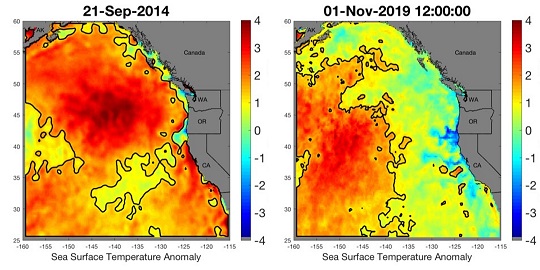|
 |
| |
Discovery Lecture Series - Postponed |
|
| |
Friday, April 3, 2020
7:00 PM - 9:00 PM
This lecture has been POSTPONED until February 5, 2021.
Marine Heatwaves of the North East Pacific: Will “Blobs” be the new normal?
By Dr. Andrew Leising, NOAA Southwest Fisheries

The marine heatwave (MHW) of 2014-2015, aka “The Blob” was an extreme event of high sea surface temperatures across a vast portion of the northeast Pacific (NEP). Areas of anomalously warm water are considered heatwaves when their temperature is greater than 90% of measurements ever taken at that location for more than 5 days in a row. To put the “Blob” and the more recent heatwave of 2019 into perspective, satellite data of sea surface temperature was analyzed from 1982 (the birth of modern sea surface temperature sensors on satellites) to fall 2019. Based on the criteria for defining a marine heatwave, the “Blob”, which began in late 2013 and continued through spring 2016, stands out in several aspects compared to a total of 225 other identified past MHWs. Various contiguous patches from the 2014/2015 event lasted > 6 months at a time. The “Blob” covered an area roughly 9.8x106 km2 at its peak, whereas the closest similar event during the preceding 32 years was only 6.4x106 km2 and short lived, occurring during the fall of 2004. Events such as 97-98 El Niño and a separate MHW during 2011 had fairly long-lived patches, however their areal extent for any particular patch was only about half that of the “Blob”. Thus the “Blob” was a truly unique feature during the time period analyzed. The only other feature to approach the size and intensity of the “Blob” is the heatwave which began this year, during late May, and is still ongoing. This current MHW is the 2nd largest MHW in the past 38 years. The biological impacts of these large MHWs, their causal dynamics, and their linkage to climate change will be discussed.
Dr. Andrew Leising received his bachelor’s degree in Biology and Marine Science from the State University of New York at Stony Brook, and his doctorate in Biological Oceanography from the University of California, San Diego, Scripps Institution of Oceanography. His research there focused on the ecology of marine crustaceans and their behavioral responses to environmental variation. After graduate school, Leising conducted further field experimental work on the behavior of micro- and macro-zooplankton under varying food and temperature regimes, at the University of Washington, Seattle. He also conducted computer-modeling experiments of ecosystem responses to oceanic variability and climate change. Currently, Leising works for the National Oceanic and Atmospheric Administration’s National Marine Fisheries Service (NOAA-Fisheries), at the Southwest Fisheries Science Center, in La Jolla and Monterey, CA. His current work focuses on the responses of fish and zooplankton to climate variability, and the characterization of oceanic variability (i.e. marine Heatwaves) to climate change, through his work as part of NOAA’s California Current Integrated Ecosystem Assessment team.
Click here for teacher resources related to this lecture.
|
Share



|
|

